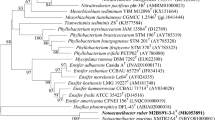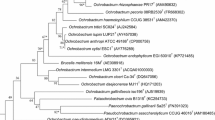Abstract
A Gram-staining negative, facultative anaerobic, motile and short rod-shaped bacterium, designated strain yh7-1T, was isolated from rhizosphere soil of Citrus sinenesis collected from the garden of Citrus sinenesis in Ailao Mountain, south-west China. Cells grew at 15–45 °C, pH 5.0–9.0 and were able to tolerate up to 1% (w/v) NaCl on R2A medium. The respiratory lipoquinone was Q-10 and the major cellular fatty acids contained summed feature 8 (C18:1 ω7c or C18:1 ω6c) and C18:0. Polar lipids in the cellular membrane were phosphatidylcholine, phosphatidylglycerol, phosphatidylethanolamine, two unidentified phospholipids and one unidentified aminophospholipid. The genomic DNA G+C content was 69.9 mol%. On basis of 16S rRNA gene sequence analysis, strain yh7-1T showed the highest similarities with Chthonobacter albigriseus KCTC 42450T (97.6%), Mongoliimonas terrestris KCTC 42635T (97.0%) and lower than 97.0% to other species. Phylogenetic trees based on 16S rRNA gene sequences indicated that strain yh7-1T clustered with C. albigriseus KCTC 42450T. The ANI values ranged between 78.1 and 82.7% for C. albigriseus KCTC 42450T, M. terrestris KCTC 42635T and strain yh7-1T, which were lower than the prokaryotic species delineation threshold of 95.0–96.0%. The digital DNA–DNA hybridization values between C. albigriseus KCTC 42450T, M. terrestris KCTC 42635T and strain yh7-1T indicated that the new isolate represents a novel genomic species. According to the phenotypic and genotypic characteristics, strain yh7-1T should belong to the genus Chthonobacter, for which the name Chthonobacter rhizosphaerae sp. nov. (type strain yh7-1T = CGMCC 1.17236T = CCTCC AB 2019258T = KCTC 82185T) is proposed.

Similar content being viewed by others
Data availability
The GenBank/EMBL/DDBJ accession number for the 16S rRNA gene sequence of strain yh7-1T is MG209703. The whole Genomes shotgun project of strain yh7-1T and Mongoliimonas terrestris KCTC 42635T have been deposited at DDBJ/ENA/GenBank under the accession numbers JACDIS000000000 and JACDIT000000000, respectively.
References
Bowman JP (2005) Family V. Methylocystaceae fam. nov. In: Brenner DJ, Krieg NR, Staley JT, Garrity GM (eds) Bergey’s manual of systematic bacteriology, vol 2, 2nd edn. (The Proteobacteria), part C (The Alpha-, Beta-, Delta-, and Epsilonproteobacteria). Springer, New York, pp 411–413
Chun J, Oren A, Ventosa A, Christensen H, Arahal DR, Costa MSd, Rooney AP, Yi H, Xu XW, Meyer SD, Trujillo ME (2018) Proposed minimal standards for the use of genome data for the taxonomy of prokaryotes. Int J Syst Bacteriol 68:461–466
Collins MD, Pirouz T, Goodfellow M, Minnikin DE (1997) Distribution of menaquinones in actinomycetes and corynebacteria. J Gen Microbiol 100:221–230
Felsenstein J (1981) Evolutionary trees from DNA sequences: a maximum likelihood approach. J Mol Evol 17:368–376
Felsenstein J (1985) Confidence limits on phylogenies: an approach using the bootstrap. Evolution 39:783–789
Fitch WM (1971) Toward defining the course of evolution: minimum change for a specific tree topology. Syst Zool 20:406–416
Goris J, Konstantinidis KT, Klappenbach JA, Coenye T, Vandamme P, Tiedje JM (2007) DNA–DNA hybridization values and their relationship to whole-genome sequence similarities. Int J Syst Evol Microbiol 57:81–91
Gregersen T (1978) Rapid method for distinction of Gram-negative from Gram-positive bacteria. Eur J Appl Microbiol Biotechnol 5:123–127
Groth I, Schumann P, Weiss N, Martin K, Rainey FA (1996) Agrococcus jenensis gen. nov., sp. nov., a new genus of actinomycetes with diaminobutyric acid in the cell wall. Int J Syst Bacteriol 46:234–239
Kim OS, Cho YJ, Lee K, Yoon SH, Kim M, Na H, Park SC, Jeon YS, Lee JH, Yi H, Won S, Chun J (2012) Introducing EzTaxon-e: a prokaryotic 16S rRNA gene sequence database with phylotypes that represent uncultured species. Int J Syst Evol Microbiol 62:716–721
Kim D, Kang K, Ahn TY (2017) Chthonobacter albigriseus gen. nov., sp. nov., isolated from grass-field soil. Int J Syst Evol Microbiol 67:883–888
Kimura M (1980) A simple method for estimating evolutionary rates of base substitutions through comparative studies of nucleotide sequences. J Mol Evol 16:111–120
Kumar SM, Stecher G, Tamura K (2016) MEGA 7: molecular evolutionary genetics analysis version 7.0 for bigger datasets. Mol Biol Evol 33:1870–1874
Li WJ, Xu P, Schumann P, Zhang YQ, Pukall R, Xu LH, Stackebrandt E, Jiang CL (2007) Georgenia ruanii sp. nov., a novel actinobacterium isolated from forest soil in Yunnan (China) and emended description of the genus Georgenia. Int J Syst Evol Microbiol 57:1424–1428
Meier-Kolthoff JP, Auch AF, Klenk HP, Göker M (2013) Genome sequence-based species delimitation with confidence intervals and improved distance functions. BMC Bioinform 14(1):60
Minnikin DE, Collins MD, Goodfellow M (1979) Fatty acid and polar lipid composition in the classification of Cellulomonas, Oerskovia and related taxa. J Appl Bacteriol 47:87–95
Minnikin DE, O’Donnell AG, Goodfellow M, Alderson G, Athalye M, Schaal A, Parlett JH (1984) An integrated procedure for the extraction of bacterial isoprenoid quinones and polar lipids. J Microbiol Methods 2:233–241
Reasoner DJ, Geldreich EF (1985) A new medium for the enumeration and subculture of bacteria from potable water. Appl Environ Microbiol 49:1–7
Richter M, Rosselló-Móra R (2009) Shifting the genomic gold standard for the prokaryotic species definition. Proc Natl Acad Sci USA 106:19126–19131
Riera N, Handique U, Zhang Y, Dewdney MM, Wang N (2017) Characterization of antimicrobial-producing beneficial bacteria isolated from Huanglongbing Escape citrus trees. Front Microbiol 8:2415
Saitou N, Nei M (1987) The neighbor-joining method: a new method for reconstructing phylogenetic tree. Mol Biol Evol 4:406–425
Sasser M (1990) Identification of bacteria by gas chromatography of cellular fatty acids, MIDI technical note 101. MIDI Inc., Newwark
Skerman VBD (1967) A guide to the identification of the genera of bacteria, 2nd edn. Williams & Wilkins, Baltimore
Smibert RM, Krieg NR (1994) Phenotypic characterization. In: Gerhardt P, Murray RGE, Wood WA, Krieg NR (eds) Methods for general and molecular bacteriology. American Society for Microbiology, Washington, pp 607–655
Thompson JD, Gibson TJ, Plewniak F, Jeanmougin F, Higgins DG (1997) The CLUSTAL_X windows interface: flexible strategies for multiple sequence alignment aided by quality analysis tools. Nucleic Acids Res 25:4876–4882
Wayne LG, Brenner DJ, Colwell RR, Grimont PAD, Kandler O, Krichevsky MI, Moore LH, Moore WEC, Murray RGE, Stackebrandt E, Starr MP, Trüper HG (1987) International Committee on Systematic Bacteriology. Report of the ad hoc committee on reconciliation of approaches to bacterial systematics. Int J Syst Bacteriol 137(463):464
Xi L, Zhang Z, Qiao N, Zhang Y, Li J, Zhao JY, Xiao Z (2016) Complete genome sequence of the novel thermophilic polyhydroxyalkanoates producer Aneurinibacillus sp. XH2 isolated from Gudao oilfield in China. J Biotechnol 227:54–55
Xi J, Wang Y, Yang XR, Tao Y, Shao YF, Feng FY (2017) Mongoliimonas terrestris gen. nov., sp. nov., isolated from desert soil. Int J Syst Evol Microbiol 67:3010–3014
Xu P, Li WJ, Tang SK, Zhang YQ, Chen GZ, Chen HH, Xu LH, Jiang CL (2005) Naxibacter alkalitolerans gen. nov., sp nov., a novel member of the family ‘Oxalobacteraceae’ isolated from China. Int J Syst Evol Microbiol 55:1149–1153
Xu J, Zhang YZ, Zhang PF, Trivedi P, Riera N, Wang YY, Liu X, Fan GY, Tang JL, Coletta-Filho HD et al (2018) The structure and function of the global citrus rhizosphere microbiome. Nat Commun 9:4894
Yoon SH, Sm Ha, Lim J, Kwon S, Chun J (2017) A large-scale evaluation of algorithms to calculate average nucleotide identity. Antonie Van Leeuwenhoek 110(10):1281–6253
Acknowledgements
The authors are grateful to Professor Jung-Sook Lee (KCTC, Korea) for kindly providing the reference type strain. This research was supported by the Foundation of China Tobacco Yunnan Industrial Co., Ltd. (2020CL04 and 2018CP04).
Author information
Authors and Affiliations
Contributions
YQD and WJL designed research and project outline. XML, ZXK, LMD performed isolation, deposition, and identification. ZXK, YDL BZF and JXJ performed fatty acids analysis. All authors read and approved the final manuscript.
Corresponding authors
Ethics declarations
Conflict of interest
The authors declare that there are no conflicts of interest.
Ethical statement
This article does not contain any studies with human participants or animals performed by any of the authors.
Additional information
Communicated by Erko Stackebrandt.
Publisher's Note
Springer Nature remains neutral with regard to jurisdictional claims in published maps and institutional affiliations.
Supplementary Information
Below is the link to the electronic supplementary material.
Rights and permissions
About this article
Cite this article
Liu, XM., Zhou, XK., Li, YD. et al. Chthonobacter rhizosphaerae sp. nov., a bacterium isolated from rhizosphere soil of Citrus sinenesis. Arch Microbiol 203, 2343–2350 (2021). https://doi.org/10.1007/s00203-021-02217-6
Received:
Revised:
Accepted:
Published:
Issue Date:
DOI: https://doi.org/10.1007/s00203-021-02217-6




